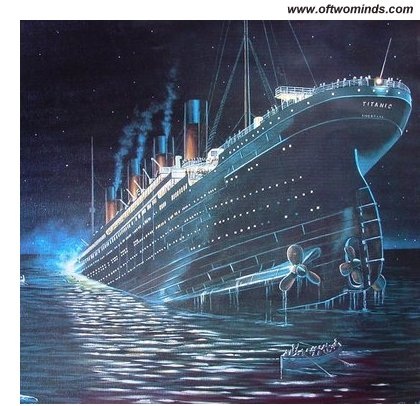All of these guarantees and redundancies are as illusory as the "unsinkable" technologies of the Titanic.
The past three decades of global growth are rarely attributed to luck: it's all the result of our brilliant fiscal, monetary and trade policies. Those in positions of wealth and power are delighted to take credit for this tremendous success, but as a general rule, the more knowledgeable you are and the higher up the food chain you are, the greater your awareness of the role of luck in any unbroken chain of success.
There are various moving parts in what we call luck. One is what we don't know but think we know, or put another way, we know enough to be confident everything will work as intended and expected.
I described how this worked in the Titanic disaster in Why Our Financial System Is Like the Titanic (March 15, 2016).
The technologies of the early 1900s enabled shipbuilders to construct enormous steel-hulled ships almost 900 feet in length capable of steaming at 24 knots, transporting passengers across the Atlantic in comfort. The technologies that made such ships and transits low risk were largely already present but in forms that were deeply flawed in ways that were not readily visible or understood.
Unbeknownst to the era's designers and shipbuilders, the Titanic's hull plates were brittle due to high sulfur content in the steel, especially at cold temperatures (the water was near freezing at the time of the collision with the iceberg).
Rather than deform as the iceberg scraped against the hull, the plates and rivets fractured, opening the irregular gash that sank the ship.
The watertight bulkheads appeared to make the ship "unsinkable," but this was only true if the hull was compromised across no more than four watertight compartments. The bulkheads may have actually accelerated the sinking, as later studies found the ship would have stayed afloat an additional six hours without any watertight bulkheads, as the ship would have settled evenly rather than sinking bow-first as the forward compartments filled.
The presence of lifeboats seemed to offer a guarantee of safety, yet outdated regulations only required enough lifeboats for half the crew and passengers.
The new technology of radio ("wireless") seemed to provide a reliable way to call for help, yet regulations did not require all ships to staff wireless stations 24 hours a day, so nearby ships never received Titanic's distress calls.
Assuming that human lookouts could detect icebergs soon enough to change course seemed realistic, and favoring the first class passengers in lifeboat access was unquestioned until after the sinking.
After the disaster, all these inadequacies (except the high sulfur steel deficiencies) became obvious, but this "obviousness" only manifested because of the disaster: if the Titanic had narrowly missed the iceberg, everyone would have continued to be resolutely confident that the ship and all the life-safety systems were not just adequate but beyond adequate.
The fact that large ships and powerful engines could be built created the illusion of low risk, because the risk factors were invisible until after the fact. The high confidence in the technologies of the day now seem quaint: the flaws in the steel plates and rivets would remain invisible until the technologies of steel production finally caught up with the other shipbuilding technologies, and better detection and tracking of icebergs would have to wait for radar and better navigational technologies.
But how different is our current extreme confidence in our healthcare technologies?
Much of what we take for granted as essentially guaranteed by our fabulous technologies and systems is more akin to the Titanic than we care to admit. That the world has avoided seriously disruptive global pandemics for a hundred years is more luck than most people understand. RNA viruses mutate at a very high rate (i.e. they replicate with imprecision, generating a high rate of mutations). Whether these mutations end up being "good" or "bad" for the human hosts is a function of randomness, i.e. luck.
The global economy has been astonishingly lucky for 30 years--or even 75 years. Like the passengers on the Titanic, we have unquestioned confidence in our technologies and systems because they appear so "guaranteed", so resilient and so redundant.
All of these guarantees and redundancies are as illusory as the "unsinkable" technologies of the Titanic. The irony is that the more knowledgeable the individual, the more they understand the role of luck in avoiding failure or catastrophe. The less we know, the more trusting we are in compelling illusions of safety and security.

My recent books:
Audiobook edition now available:
Will You Be Richer or Poorer?: Profit, Power, and AI in a Traumatized World ($13)
(Kindle $6.95, print $11.95) Read the first section for free (PDF).
Will You Be Richer or Poorer?: Profit, Power, and AI in a Traumatized World ($13)
(Kindle $6.95, print $11.95) Read the first section for free (PDF).
Pathfinding our Destiny: Preventing the Final Fall of Our Democratic Republic ($6.95 (Kindle), $12 (print), $13.08 ( audiobook): Read the first section for free (PDF).
The Adventures of the Consulting Philosopher: The Disappearance of Drake $1.29 (Kindle), $8.95 (print); read the first chapters for free (PDF)
Money and Work Unchained $6.95 (Kindle), $15 (print) Read the first section for free (PDF).
If you found value in this content, please join me in seeking solutions by becoming a $1/month patron of my work via patreon.com.
If you found value in this content, please join me in seeking solutions by becoming a $1/month patron of my work via patreon.com.
NOTE: Contributions/subscriptions are acknowledged in the order received. Your name and email remain confidential and will not be given to any other individual, company or agency.
Thank you, Kenneth B. ($10), for your most generous contribution to this site -- I am greatly honored by your support and readership.
|
Thank you, Shawn K. ($20), for your very generous contribution to this site -- I am greatly honored by your support and readership.
|
